 |
 |
 |
| |
Patient Reported Outcomes after Simplification to a Single Tablet Regimen of Efavirenz (EFV) / Emtricitabine (FTC) / Tenofovir DF (TDF)
|
| |
| |
Reported by Jules Levin
Glasgow, Nov 10 2008
S. Hodder1, K. Mounzer2,3, E. DeJesus4, J-F. Maa5, R. Ebrahimi6, K. Grimm5, J. Flaherty6, A. Farajallah5 for the AI266073 Study Team
1University of Medicine and Dentistry of NJ, Newark, NJ, 2Philadelphia FIGHT, Philadelphia, PA, 3University of Pennsylvania, School of Medicine, 4Orlando Immunology Center, Orlando, FL, 5Bristol-Myers Squibb, Princeton, NJ, 6Gilead Sciences, Foster City, CA
AUTHOR CONCLUSIONS
Simplification to a EFV/FTC/TDF single tablet regimen from a variety of ART regimens maintained high levels of virologic suppression
Adherence and Quality of Life were both high at baseline and remained high
throughout the duration of the study
Patients who switched to EFV/FTC/TDF single tablet regimen reported improvements in several HIV-related symptoms including diarrhea, bloating, pain, gas, changes in the way their body looked and problems having sex
Patients who switched to EFV/FTC/TDF single tablet regimen experienced a transient worsening of dizziness or lightheadedness symptoms (at Week 4 only)
Among patients randomized to EFV/FTC/TDF, 91% indicated a preference for the single tablet regimen compared to prior therapy, and 97% found EFV/FTC/TDF easy to take
BACKGROUND/OBJECTIVES
· Co-formulated efavirenz (EFV), emtricitabine (FTC), and tenofovir disoproxil fumarate (TDF) is the first once-a-day single tablet antiretroviral regimen approved in the United States, Canada and Europe. The components have demonstrated efficacy and safety in HIV treatment-na´ve patients.1
· This study aimed to evaluate the efficacy, safety, tolerability, and patient reported outcomes associated with a single tablet regimen simplification strategy in patients on HAART who have achieved viral suppression.
· The primary efficacy results for this study were presented at the 2008 ICAAC/IDSA meeting.2 Additional efficacy results will also be presented as a separate poster here at the HIV9 conference.3 Here we present patient-reported outcomes.
METHODS
In addition to signing an informed written consent, subjects had to complete an enrollment survey to evaluate the reason for their willingness to switch to EFV/FTC/TDF, including:
- "Desire to simplify your current anti-HIV regimen"
- "I am not tolerating the current regimen well because of side effects"
- "I am concerned about the long-term side effects of my current anti HIV regimen"
- "I am having trouble taking my current regimen on a regular basis
- Note: Subjects could select as many reasons for participation as needed
The following patient reported outcomes were collected in both treatment arms:
Adherence by Visual Analog Scale
-- Subjects describe their adherence to their ART regimen by marking a linear scale
-- This measure minimizes response burden while demonstrating equivalent or slightly superior (non-significant) validity relative to standard and widely-used 3-day self-reports4,5
-- Change from baseline in adherence scores in both treatment arms and between arms at weeks 4, 12, 24, 36, & 48 were measured
Quality of Life (QOL) by SF-36 (v2) survey6,7
-- Validated questionnaire which takes approximately 10 minutes to complete
-- Assesses eight health dimensions (physical functioning, social functioning, general health, vitality, bodily pain, mental health, role capacity-physical, and role-capacity-emotional)
-- Change from baseline in Quality of Life (QOL) scores in both treatment arms and between arms at weeks 4, 12, 24, & 48 were measured
HIV Symptoms Index by a 20-item survey
-- 20-item self-reported measure which requires 5 minutes to complete8
-- Addresses presence and perceived distress linked to symptoms commonly associated with HIV or its treatment:
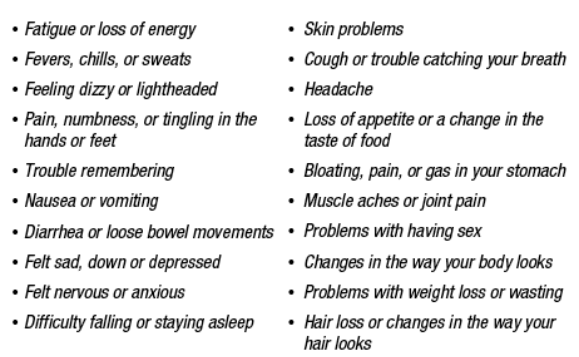
-- The Adult AIDS Clinical Trials Group has classified this measure as a standard
instrument and included it in their trials8
-- Change from baseline in HIV Symptom Index in both treatment arms at weeks 4, 12, 24, 36, & 48 was measured
Perceived Ease of the Regimen for Condition (PERC) questionnaire
-- A single indicator on perceived ease or difficulty of regimen, developed for this
study, was utilized
-- Query is as follows: Medications vary with respect to number of pills, frequency, and timing of taking medication, and other instructions. "How easy did you find it to follow your current HIV medications regimen"
-- Responses were: (1) Very Easy; (2) Somewhat Easy; (3) Somewhat Difficult; (4) Very Difficult
-- Change from baseline in perceived difficulty or ease of regimen in both treatment arms at weeks 4, 12, 24, 36, & 48 was measured
-- In the final statistical analysis compared "Very Easy" and "Not Very Easy," with
responses of "Somewhat Easy," "Somewhat Difficult," and "Very Difficult" being classified as "Not Very Easy"
In the EFV/FTC/TDF arm only, the following was collected--
Preference of Medication (POM) questionnaire
--Single item measure adapted from Neuroscience studies to be utilized within an
HIV population
-- The single query was: "How does this current medicine compare to the previous HAART medicine(s) your doctor prescribed for your HIV infection?"
-- The response set is as follows: (1) Much Better, I prefer this medication; (2)
Slightly Better; (3) About the Same; (4) Slightly Worse; (5) Much Worse, I much
prefer my previous medication
-- Change from baseline in POM in the EFV/FTC/TDF arm at weeks 4, 12, 24, 36, & 48 was measured
RESULTS
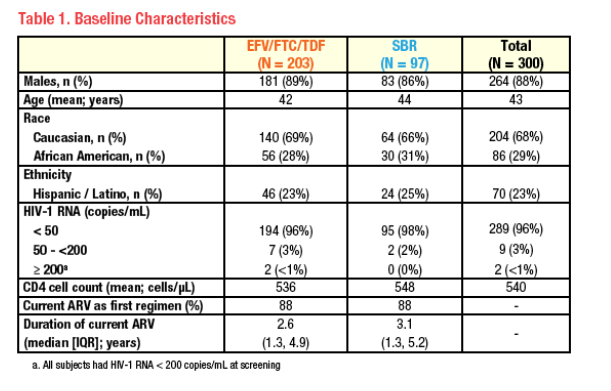
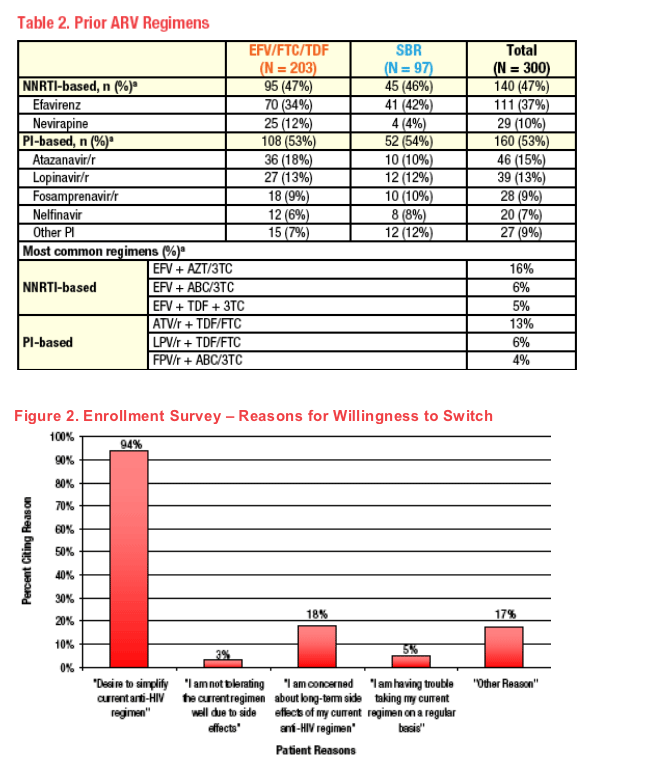
Other Reasons responses included: "curious," "cost," "hope to find a cure," "interested in research," "lipoatrophy," "asked by doctor to participate," "to help in the understanding of what this could do for others"
Efficacy Analysis - Week 48
Through 48 weeks, 89% vs. 88% in the EFV/FTC/TDF vs. SBR arms, respectively, maintained HIV-1 RNA < 200 copies/mL by TLOVR (ITT; M=F) and demonstrated the non-inferiority of EFV/FTC/TDF to SBR
- See poster number P061 (Young B et al.)
Adherence by Visual Analog
Adherence in both arms at baseline and all study visits was ≥ 96%
There were no marked or statistically significant changes in adherence for either arm during the study
Quality of Life SF-36 Scores
Baseline SF-36 scores were similar to the general non-HIV infected population at baseline and all visits
There were no marked or statistically significant changes in SF-36 scores for either arm during the study (for all individual health dimensions)

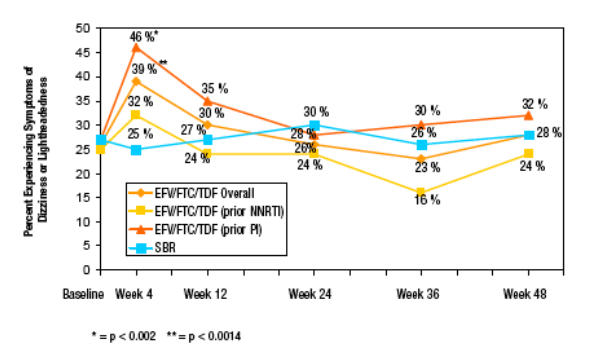
There was a transient worsening of dizziness or lightheadedness symptoms (observed at Week 4 only) in patients switched to EFV/FTC/TDF, primarily in patients who switched from a PI-based regimen
All other symptoms evaluated by the HIV Symptoms Index did not show statistically significant improvement or worsening in either arm for the overall study population or in the prior PI- or NNRTI stratum.
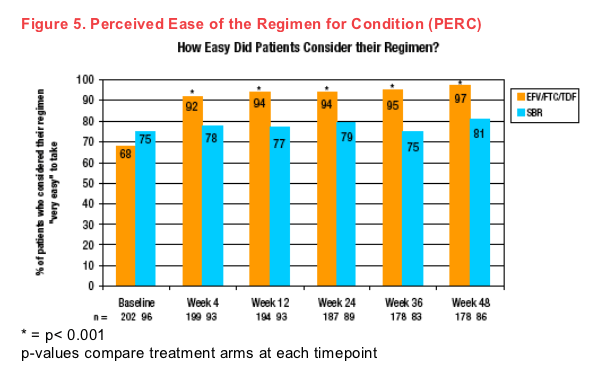
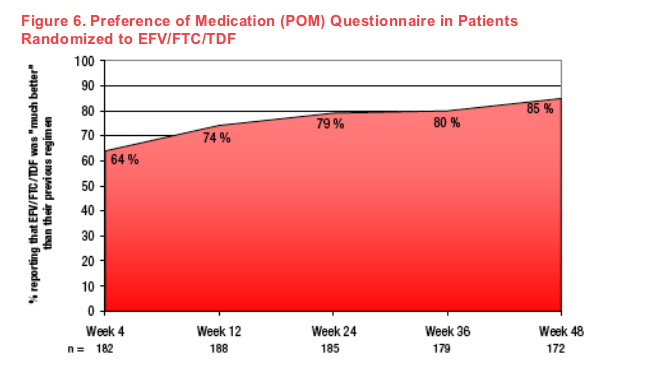
By Week 48, 82% and 88% preferred the EFV/FTC/TDF regimen in the NNRTI and PI strata, respectively
By Week 48, 91% found the EFV/FTC/TDF regimen "Much Better" or "Slightly Better" than their previous regimen
By Week 48, no subjects receiving EFV/FTC/TDF considered it to be worse than their previous regimen.
Ten subjects reported that they much preferred their previous regimen on at least one occasion during the study
-- Of these 10 subjects, four had received prior PI based regimens and six had received prior NNRTI based regimens
-- Three subjects completed the study, two withdrew consent, and five discontinued due to AEs
-- Of the five subjects who discontinued due to AEs, one received a prior NNRTI based regimen and four received a prior PI based regimen
REFERENCES
1. Gallant J, DeJesus E, Arribas J, et al. Tenofovir DF, emtricitabine and efavirenz vs. fixed dose zidovudine, lamivudine and efavirenz for HIV. New England Journal of Medicine 2006; 354:251-60.
2. DeJesus E, Young B, Flaherty J, et al. Simplification of Antiretroviral Therapy with Efavirenz/Emtricitabine/Tenofovir DF Single Tablet Regimen vs. Continued Unmodified Antiretroviral Therapy in Virologically-Suppressed, HIV-1-Infected Patients. Presented at: ICAAC/IDSA Annual Meeting(s); October 25-28, 2008; Washington, DC, USA. Poster H-1234.
3. Young B, DeJesus E, Morales-Ramirez JO, et al. Simplification of Therapy (ART) with Efavirenz/Emtricitabine/Tenofovir DF Single Tablet Regimen vs. Continued ART in Suppressed, HIVInfected Patients. Presented at: HIV9 Congress; November 9-13, 2008; Glasgow, United Kingdom.
Poster P061.
4. Giordano T, Guzman D, Clark R, et al. Measuring adherence to antiretroviral therapy in a diverse population using a visual analogue scale. HIV Clinical Trials 2004; 5(2): 74-79.
5. Walsh J, Mandalia S, Gazzard B. Responses to a one month self-report on adherence to antiretroviral therapy are consistent with electronic data and virological treatment outcome. AIDS. 2002; 16:269-277.
6. Ware J, Snow K, Kosinski M, et al. Health Survey: manual and interpretation guide. The Health Institute, New England Medical Center, Boston, MA, 1993.
7. Ware J, Bayliss M, Mannocchia M, et al . Health-related quality of life in chronic hepatitis C: impact
of disease and treatment response. Hepatology. 1999; 30:550-5.
8. Justice A, Holmes W, Gifford A, et al. Development and validation of a self completed HIV symptom index. Journal of Clinical Epidemiology. 2001; 54:S77-S90.
|
| |
|
 |
 |
|
|